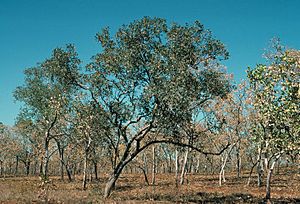Koolpin box facts for kids
Quick facts for kids Koolpin box |
|
|---|---|
 |
|
| Eucalyptus koolpinensis in Kakadu National Park | |
| Scientific classification | |
| Genus: |
Eucalyptus
|
| Species: |
koolpinensis
|
The Koolpin box (scientific name: Eucalyptus koolpinensis) is a special type of tree found only in the Northern Territory of Australia. It's often a straggly tree, meaning it doesn't grow perfectly straight. You can spot it by its rough, fibrous bark on its trunk and branches. It has roundish adult leaves, flower buds that grow in groups of seven, creamy white flowers, and fruit shaped like a cup.
What Does the Koolpin Box Look Like?
The Koolpin box is a straggly tree that usually grows about 5 metres (16 feet) tall. Sometimes, it can reach up to 12 metres (39 feet). This tree has a special woody swelling at its base called a lignotuber. This helps the tree regrow after fires or damage.
Its bark is rough and grey or grey-white. It covers the trunk and even the smaller branches. The bark is tightly packed, like a "box-type" bark, and can look like a checkerboard pattern on the main trunk.
Young Koolpin box plants and new shoots (called coppice regrowth) have dull bluish-green leaves. These leaves are usually round, egg-shaped, or even kite-shaped. They are about 40 to 90 millimetres (1.6 to 3.5 inches) long and 45 to 90 millimetres (1.8 to 3.5 inches) wide.
The adult leaves grow one after another along the stem. They are dull blue-green on both sides and are also round or kite-shaped. These leaves are typically 40 to 100 millimetres (1.6 to 3.9 inches) long and 35 to 85 millimetres (1.4 to 3.3 inches) wide. Each leaf has a stalk, called a petiole, which is about 13 to 30 millimetres (0.5 to 1.2 inches) long.
The flower buds grow at the ends of the branches. They are arranged on a branching stalk, called a peduncle, which is 5 to 20 millimetres (0.2 to 0.8 inches) long. Each small branch of the peduncle holds seven buds. Each individual bud sits on a tiny stalk, called a pedicel, which is 5 to 12 millimetres (0.2 to 0.5 inches) long.
When the buds are ready to open, they are pear-shaped. They are about 7 to 9 millimetres (0.3 to 0.4 inches) long and 4 to 5 millimetres (0.16 to 0.20 inches) wide. The top part of the bud, which looks like a beak, is called the operculum.
The Koolpin box flowers between April and June. Its flowers are a lovely creamy white colour. After flowering, the tree produces woody, cup-shaped fruits. These fruits are called capsules and are about 5 to 8 millimetres (0.2 to 0.3 inches) long and 5 to 7 millimetres (0.2 to 0.3 inches) wide. The seeds inside are dark brown, oval, and very small, about 1.5 to 3 millimetres (0.06 to 0.12 inches) long.
How Did It Get Its Name?
The Koolpin box was first officially described by two botanists, Ian Brooker and Clyde Dunlop, in 1978. They published their description in a science journal called Australian Forest Research.
The second part of its scientific name, koolpinensis, comes from Koolpin Creek. This creek is in the Northern Territory, which is where the first example of this tree (called the type specimen) was collected for study.
Where Does the Koolpin Box Grow?
The Koolpin box mostly grows near the edges of rocky sandstone areas. It prefers shallow soil and can also be found on the edges of nearby flat plains. Often, you'll see many Koolpin box trees growing together in groups.
This tree is only found in two specific places in Australia. These locations are between the South Alligator River and a place called Koolpin Gorge.

